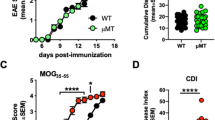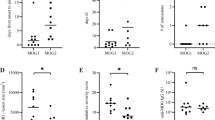Abstract
The diversity of autoimmune responses poses a formidable challenge to the development of antigen-specific tolerizing therapy. We developed 'myelin proteome' microarrays to profile the evolution of autoantibody responses in experimental autoimmune encephalomyelitis (EAE), a model for multiple sclerosis (MS). Increased diversity of autoantibody responses in acute EAE predicted a more severe clinical course. Chronic EAE was associated with previously undescribed extensive intra- and intermolecular epitope spreading of autoreactive B-cell responses. Array analysis of autoantigens targeted in acute EAE was used to guide the choice of autoantigen cDNAs to be incorporated into expression plasmids so as to generate tolerizing vaccines. Tolerizing DNA vaccines encoding a greater number of array-determined myelin targets proved superior in treating established EAE and reduced epitope spreading of autoreactive B-cell responses. Proteomic monitoring of autoantibody responses provides a useful approach to monitor autoimmune disease and to develop and tailor disease- and patient-specific tolerizing DNA vaccines.
This is a preview of subscription content, access via your institution
Access options
Subscribe to this journal
Receive 12 print issues and online access
$209.00 per year
only $17.42 per issue
Buy this article
- Purchase on Springer Link
- Instant access to full article PDF
Prices may be subject to local taxes which are calculated during checkout





Similar content being viewed by others
References
Milich, D.R., McLachlan, A., Thornton, G.B. & Hughes, J.L. Antibody production to the nucleocapsid and envelope of the hepatitis B virus primed by a single synthetic T-cell site. Nature 329, 547–549 (1987).
Lehmann, P.V., Forsthuber, T., Miller, A. & Sercarz, E.E. Spreading of T-cell autoimmunity to cryptic determinants of an autoantigen. Nature 358, 155–157 (1992).
Yu, M., Johnson, J.M. & Tuohy, V.K. A predictable sequential determinant spreading cascade invariably accompanies progression of experimental autoimmune encephalomyelitis: a basis for peptide-specific therapy after onset of clinical disease. J. Exp. Med. 183, 1777–1788 (1996).
James, J.A., Gross, T., Scofield, R.H. & Harley, J.B. Immunoglobulin epitope spreading and autoimmune disease after peptide immunization: Sm B/B'-derived PGMRPP and PGIRGP induce spliceosome autoimmunity. J. Exp. Med. 181, 453–461 (1995).
Tisch, R. & McDevitt, H. Insulin-dependent diabetes mellitus. Cell 85, 291–297 (1996).
McRae, B.L., Vanderlugt, C.L., Dal Canto, M.C. & Miller, S.D. Functional evidence for epitope spreading in the relapsing pathology of experimental autoimmune encephalomyelitis. J. Exp. Med. 182, 75–85 (1995).
Genain, C., Cannella, B., Hauser, S. & Raine, C. Identification of autoantibodies associated with myelin damage in multiple sclerosis. Nat. Med. 5, 170–175 (1999).
Genain, C.P. et al. Late complications of immune deviation therapy in a nonhuman primate. Science 274, 2054–2057 (1996).
Steinman, L. Multiple sclerosis: a coordinated immunological attack against myelin in the central nervous system. Cell 85, 299–302 (1996).
Garren, H. et al. Combination of gene delivery and DNA vaccination to protect from and reverse Th1 autoimmune disease via deviation to the Th2 pathway. Immunity 15, 15–22 (2001).
Wekerle, H. Remembering MOG: autoantibody-mediated demyelination in multiple sclerosis? Nat. Med. 5, 153–154 (1999).
Robinson, H.L., Hunt, L.A. & Webster, R.G. Protection against a lethal influenza virus challenge by immunization with a haemagglutinin-expressing plasmid DNA. Vaccine 11, 957–960 (1993).
Ulmer, J.B. et al. Heterologous protection against influenza by injection of DNA encoding a viral protein. Science 259, 1745–1749 (1993).
Ruiz, P. et al. Suppressive immunization with DNA encoding a self-protein prevents autoimmune disease: modulation of T cell costimulation. J. Immunol. 162, 3336–3341 (1999).
Ramshaw, I.A. et al. DNA vaccines for the treatment of autoimmune disease. Immunol. Cell Biol. 75, 409–413 (1997).
Urbanek-Ruiz, I. et al. Immunization with DNA encoding an immunodominant peptide of insulin prevents diabetes in NOD mice. Clin. Immunol. 100, 164–171 (2001).
Balasa, B. et al. Vaccination with glutamic acid decarboxylase plasmid DNA protects mice from spontaneous autoimmune diabetes and B7/CD28 costimulation circumvents that protection. Clin. Immunol. 99, 241–252 (2001).
Bot, A. et al. Plasmid vaccination with insulin B chain prevents autoimmune diabetes in nonobese diabetic mice. J. Immunol. 167, 2950–2955 (2001).
Robinson, W.H. et al. Autoantigen microarrays for multiplex characterization of autoantibody responses. Nat. Med. 8, 295–301 (2002).
Zamvil, S. et al. T-cell clones specific for myelin basic protein induce chronic relapsing paralysis and demyelination. Nature 317, 355–358 (1985).
Tusher, V.G., Tibshirani, R. & Chu, G. Significance analysis of microarrays applied to the ionizing radiation response. Proc. Natl. Acad. Sci. USA 98, 5116–5121 (2001).
Eisen, M.B., Spellman, P.T., Brown, P.O. & Botstein, D. Cluster analysis and display of genome-wide expression patterns. Proc. Natl. Acad. Sci. USA 95, 14863–14868 (1998).
Noseworthy, J.H., Lucchinetti, C., Rodriguez, M. & Weinshenker, B.G. Multiple sclerosis. N. Engl. J. Med. 343, 938–952 (2000).
Morris-Downes, M.M. et al. Encephalitogenic and immunogenic potential of myelin-associated glycoprotein (MAG), oligodendrocyte-specific glycoprotein (OSP) and 2',3′-cyclic nucleotide 3′-phosphodiesterase (CNPase) in ABH and SJL mice. J. Neuroimmunol. 122, 20–33 (2002).
Shlomchik, M.J., Craft, J.E. & Mamula, M.J. From T to B and back again: positive feedback in systemic autoimmune disease. Nat. Rev. Immunol. 1, 147–153 (2001).
Goverman, J. et al. Transgenic mice that express a myelin basic protein-specific T cell receptor develop spontaneous autoimmunity. Cell 72, 551–560 (1993).
Fazekas de St, G. & Webster, R.G. Disquisitions of original antigenic sin. I. Evidence in man. J. Exp. Med. 124, 331–345 (1966).
Klenerman, P. & Zinkernagel, R.M. Original antigenic sin impairs cytotoxic T lymphocyte responses to viruses bearing variant epitopes. Nature 394, 482–485 (1998).
Tuohy, V.K., Yu, M., Yin, L., Kawczak, J.A. & Kinkel, R.P. Spontaneous regression of primary autoreactivity during chronic progression of experimental autoimmune encephalomyelitis and multiple sclerosis. J. Exp. Med. 189, 1033–1042 (1999).
Steinman, L. Absence of “original antigenic sin” in autoimmunity provides an unforeseen platform for immune therapy. J. Exp. Med. 189, 1021–1024 (1999).
Critchfield, J.M. et al. T cell deletion in high antigen dose therapy of autoimmune encephalomyelitis. Science 263, 1139–1143 (1994).
Brocke, S. et al. Treatment of experimental encephalomyelitis with a peptide analogue of myelin basic protein. Nature 379, 343–346 (1996).
Boon, L. et al. Prevention of experimental autoimmune encephalomyelitis in the common marmoset (Callithrix jacchus) using a chimeric antagonist monoclonal antibody against human CD40 is associated with altered B cell responses. J. Immunol. 167, 2942–2949 (2001).
Miller, S.D. et al. Blockade of CD28/B7-1 interaction prevents epitope spreading and clinical relapses of murine EAE. Immunity 3, 739–745 (1995).
Tisch, R. et al. Immune response to glutamic acid decarboxylase correlates with insulitis in non-obese diabetic mice. Nature 366, 72 (1993).
Yu, L. et al. Early expression of antiinsulin autoantibodies of humans and the NOD mouse: evidence for early determination of subsequent diabetes. Proc. Natl. Acad. Sci. USA 97, 1701–1706 (2000).
Robinson, W.H., Garren, H., Utz, P.J. & Steinman, L. Millennium Award. Proteomics for the development of DNA tolerizing vaccines to treat autoimmune disease. Clin. Immunol. 103, 7–12 (2002).
Warren, K., Katz, I. & Steinman, L. Fine specificity of the antibody response to myelin basic protein in the central nervous system in multiple sclerosis: the minimal B cell epitope and a model of its unique features. Proc. Natl. Acad. Sci. USA 92, 11061–11065 (1995).
Haab, B.B., Dunham, M.J. & Brown, P.O. Protein microarrays for highly parallel detection and quantitation of specific proteins and antibodies in complex solutions. Genome Biol. 2, research0004.0001–0004.0013 (2001).
Pedotti, R. et al. An unexpected version of horror autotoxicus: anaphylactic shock to a self-peptide. Nat. Immunol. 2, 216–222 (2001).
Storey, J.D. A direct approach to false discovery rates. J.R. Stat. Soc. Ser. B-Stat. Methodol. 64, 479–498 (2002).
Acknowledgements
The authors thank members of the Steinman and Utz laboratories for scientific input. This work was supported by National Institutes of Health (NIH) K08 AR02133, an Arthritis Foundation Chapter Grant and Investigator Award and NIH NHLBI contract N01 HV 28183 to W.H.R; an Arthritis Foundation Investigator Award and Chapter Grant, a Baxter Foundation Career Development Award, a Program in Molecular and Genetic Medicine Grant, NIH grants DK61934, AI50864, AI50865, AI51614, AR49328, and NIH NHLBI contract N01-HV-28183 to P.J.U.; and NIH NINDS 5R01NS18235, NIH U19 DK61934 and NIH NHLBI contract N01-HV-28183 to L.S.
Author information
Authors and Affiliations
Corresponding author
Ethics declarations
Competing interests
H.G. is an employee of, and owns shares of stock in, Bayhill Therapeutics. W.H.R., P.J.U and L.S. receive financial compensation for consulting for, and own shares of stock in, Bayhill Therapeutics.
Supplementary information
Rights and permissions
About this article
Cite this article
Robinson, W., Fontoura, P., Lee, B. et al. Protein microarrays guide tolerizing DNA vaccine treatment of autoimmune encephalomyelitis. Nat Biotechnol 21, 1033–1039 (2003). https://doi.org/10.1038/nbt859
Received:
Accepted:
Published:
Issue Date:
DOI: https://doi.org/10.1038/nbt859
This article is cited by
-
Integrative analysis of genetic data sets reveals a shared innate immune component in autism spectrum disorder and its co-morbidities
Genome Biology (2016)
-
Development of therapies for autoimmune disease at Stanford: a tale of multiple shots and one goal
Immunologic Research (2014)
-
Mechanistic biomarkers for clinical decision making in rheumatic diseases
Nature Reviews Rheumatology (2013)
-
IL-27 acts on DCs to suppress the T cell response and autoimmunity by inducing expression of the immunoregulatory molecule CD39
Nature Immunology (2013)
-
On silico peptide microarrays for high-resolution mapping of antibody epitopes and diverse protein-protein interactions
Nature Medicine (2012)



